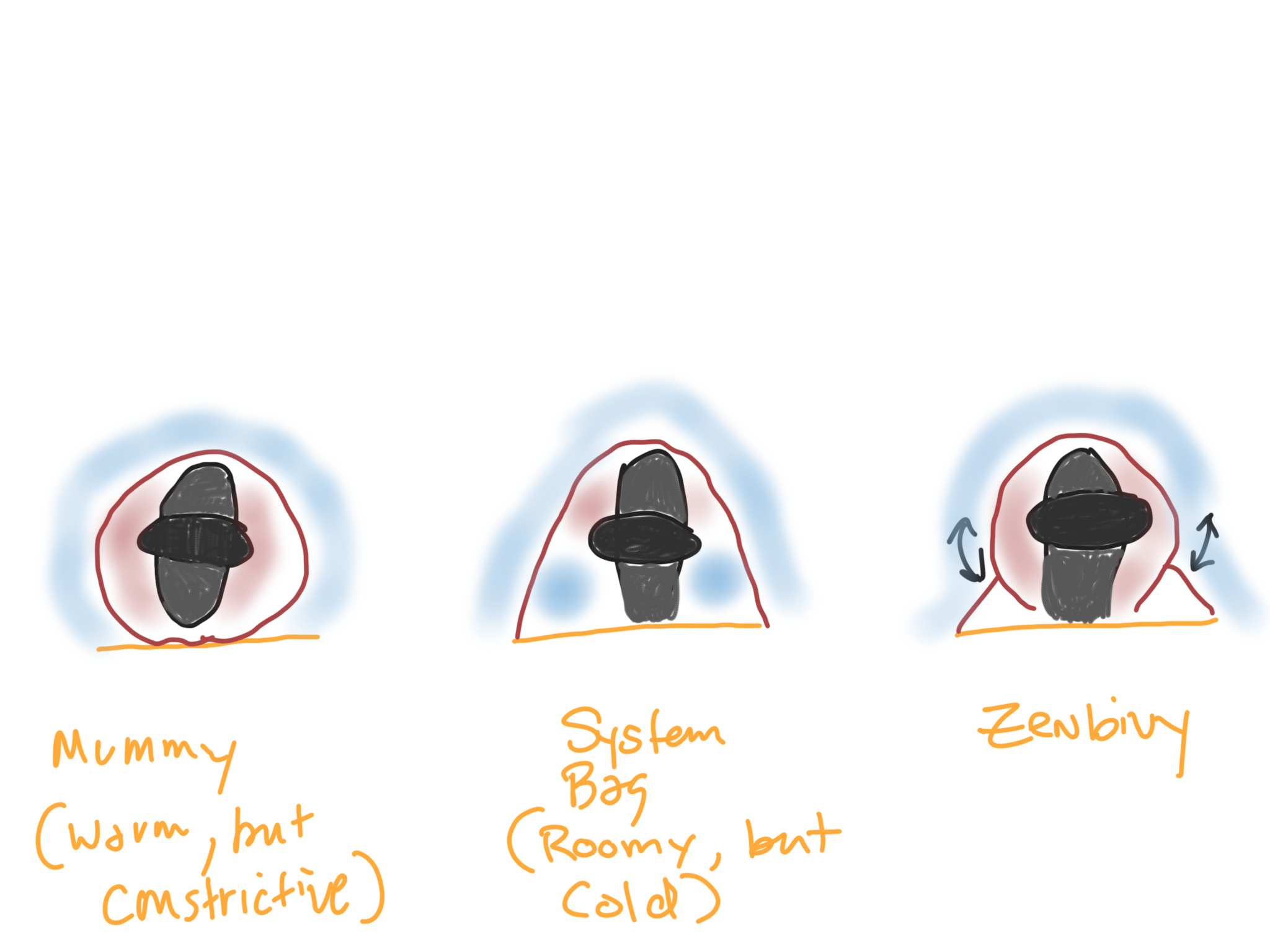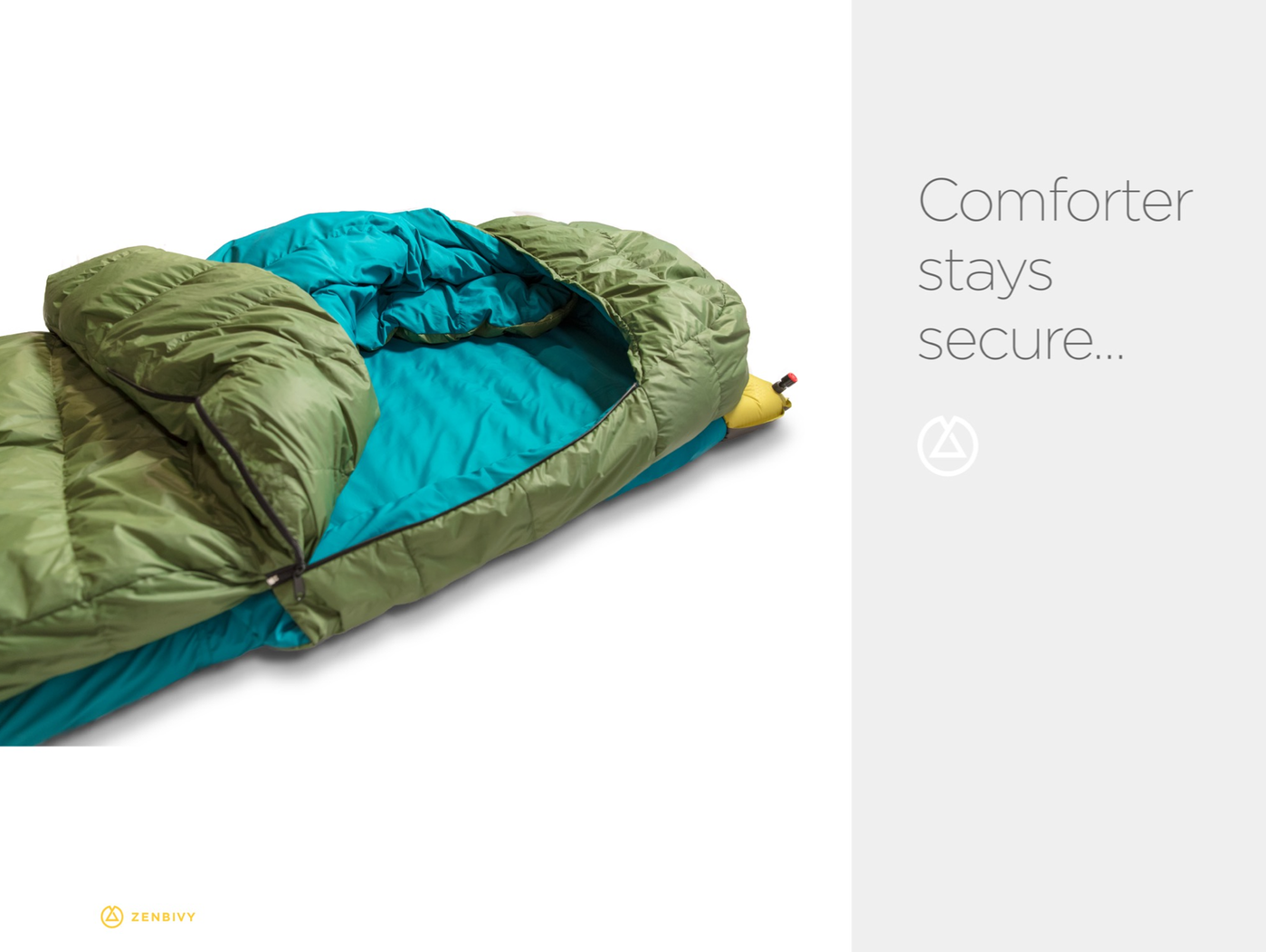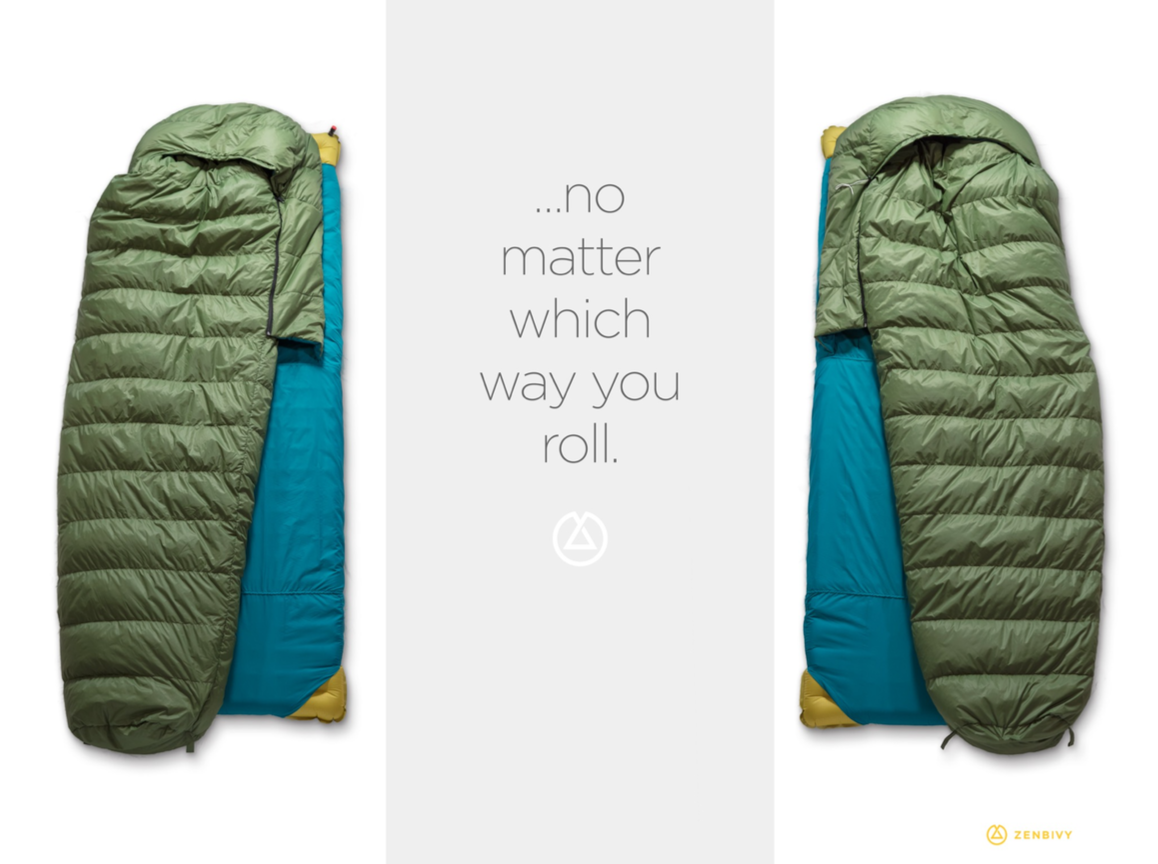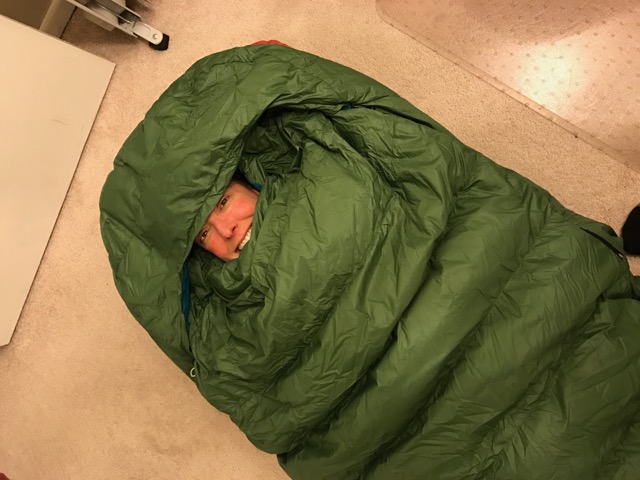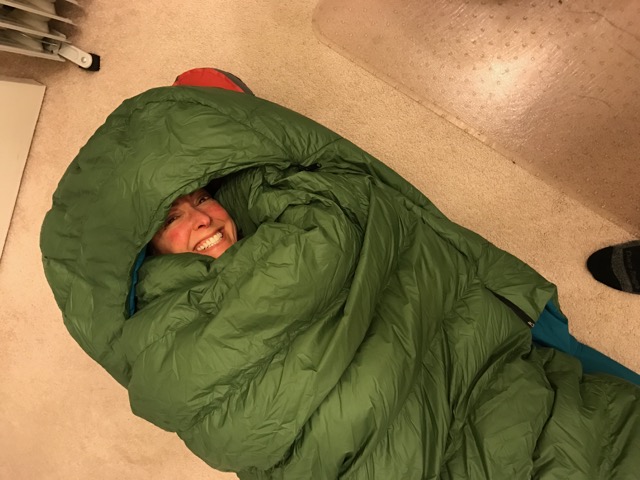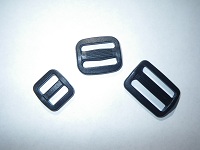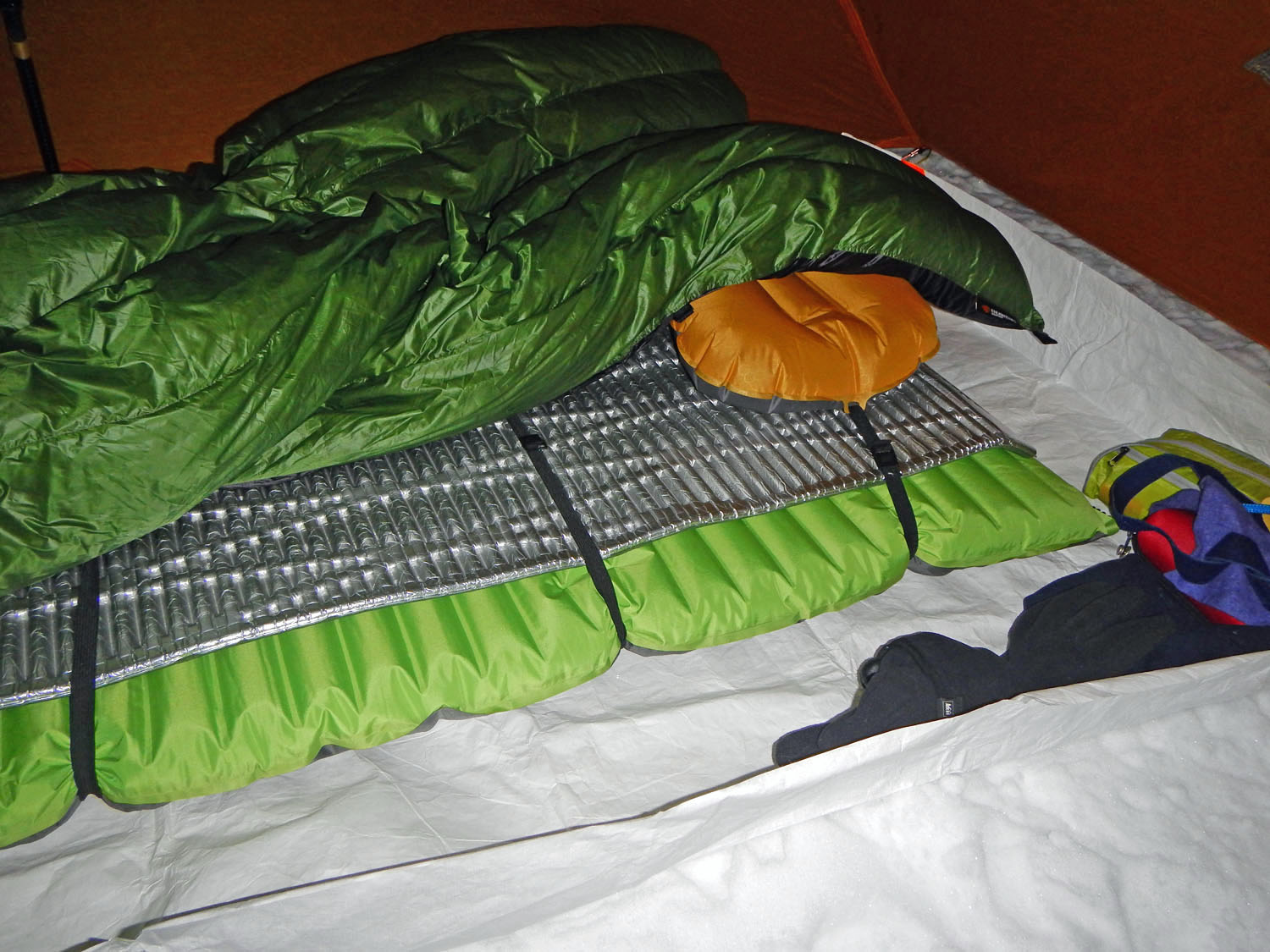Topic
NEW quilt / pad interface from ZENBIVY
Forum Posting
A Membership is required to post in the forums. Login or become a member to post in the member forums!
Home › Forums › Gear Forums › Gear (General) › NEW quilt / pad interface from ZENBIVY
- This topic has 47 replies, 15 voices, and was last updated 6 years, 4 months ago by
 Michael Glavin / Zenbivy.
Michael Glavin / Zenbivy.
-
AuthorPosts
-
Feb 21, 2017 at 12:55 pm #3451809
BPL Community:
I have developed a new way to attach a quilt to a mattress, in an effort to solve some of the issues with using quilts while capitalizing on the advantages. I’d like to hear the community’s initial thoughts and critiques.
*disclosure note: this is a commercial project, patents are pending, I am the inventor, the brand is ZENBIVY. Since it is not for sale, I believe I am posting in the correct location….
*note 2: The design goal of the product shown in the examples was to “combine the warmth and weight of a mummy bag with the comfort of your bed at home, so you have a single solution that can be used for summertime through full 3 season use, while being light enough for backpacking and comfortable enough for car camping” As such, the product shown weighs the same as a comparably spec’d mummy bag of the same EN rating (specs at the very end of the post).
As most folks here already know, a quilt is extremely comfortable because it already sleeps like a bed at home. Specifically, it allows the user to control the interior girth of the bag to regulate temperature just like you do at home. Just like you do naturally in your bed at home at night, when you are cold you wrap the covers tightly around you, and as you warm up you can expand naturally. It also has “covers” that mimic those at home, and it eliminates the restriction associated with mummy bags (pinned inside) and system bags (pinned to the mattress).
But as you are all aware, the quilt has two big problems that keep it from being a total solution for most people, both of which the new design attempts to solve:
1. insulating the head
2. quilt falls off the mattressIt would seem simple so solve the quilt falling off the mattress problem: just attach the two. But doing that creates two huge problems:
1. You lose the adjustable girth. If you attach the quilt to the edge of the pad, it creates too large an interior (if its big enough to roll around in), and two “cold spots” which are worst when you are on your side. (note: Katabatic Gear has largely solved this for ultra-lighters with their string-based system, also patented or patent pending I believe)
2. You are adding constriction by pinning the user to the mattress. (note: my last attempt at this, the Sierra Designs Backcountry Bed, provided adjustable girth (and head insulation), but suffered badly from the “pinning” phenomenon (and was ultimately not able to match the mummy in terms of weight and thermal efficiency).Zenbivy’s solution is to attach the TOP of the quilt to the mattress with “hinges”. These hinges allow un-restriced girth adjustment (unlike Katabatic) AND they allow the quilt to “float”, eliminating pinning. This terrible sketch (sorry) compares our bed to mummies and a system bag that attaches the quilt to the pad:

The hinges allow unrestricted movement of the quilt UNTIL the point just before the quilt falls off the pad, and then they “engage”, so there is no way to “un-tuck” the quilt while it is attached. So you get full, unrestricted movement until you are about to lose the thermal seal, then it “catches”.
One really cool thing about using the hinges, is that they ALSO help solve the head insulation issue, because the hinges are attached to a hood, which is also separate from the quilt and attached to the mattress. When “tucked in” (zipped up), the quilt is forced into the hood and creates a fully enclosed and sealed head/neck area.
***quick note for ultra lighters: as you look at the following photos, you will quickly see that opportunities to reduce weight abound, especially when you start thinking about the pad and that bag as a single “thing”, vs. the bag/mattress mindset we have been in historically.
Unlike any bag on the market that I know of (please tell me if you can think of another), this bag as two parts, in addition to the mattress. (note: before you hammer me, I realize the model in the image is undersized. She is 5’4″ I believe, and this is the big quilt that fits to 6’6″ AND a “large” 25 x 77 mattress. It was the bag I had for the shoot, and the model I had, and is not intended to deceive).

You can see we covered the mattress with a sheet entirely (big weight investment) to solve the problem of sleeping directly on the cold, slick mattress.
This image shows how it “tucks in”, and shows how the “hinges” and the “hood” are connected into a single piece (called the yolk), and how it all zips together. Note that hoods are generally thought of as being there for your head, but this one is super-large and allows full access to the entire mattress, and is as much for your arms as your head.

This image shows how the quilt “floats” unrestricted on the “hinges”:

These images show how you would “tuck in” to sleep on a cold night. There are no draw cords or constructions. You just tuck the quilt into the hood. It stays there because of the way the quilt is attached to the hinges forces the quilt inside. You just roll to a comfortable spot, and adjust the “covers” like you would in your bed at home. The quilt fills the hood area naturally.



Clearly, one advantage of this system, especially for those who read these forums, is that you can use the quilt on its own, just like any other quilt. And since the “sheets” and “comforters” are separate, they can be mixed and matched (they use YKK MUSI zippers that are intended for inter-changeability). What other advantages can you see?
One big disadvantage is the reliance on a proper sized pad for your “sheet”. What other disadvantages can you see?
I’d love to hear comments on the system in general. AND I’d love to hear your thoughts about where something like this could go, especially from the “ultra-light” perspective. As always, I appreciate your insights….
***Final note, since I said it weighs “the same” as a mummy bag and I know I will be asked, the sample shown is a M/L quilt (fits to 6’6″) and uses a sheet that fits a “large” 25 x77 mattress. It has an anticipated EN rating of 25 degrees, 650 fill power down, a 30d shell and a 50d liner/sheet. As shown it weighs 2 pounds,7 ounces. The S/M quilt (fits to 6′) with a “standard” 20 x72 sheet of the same specs is anticipated to weigh 2 pounds, 2-3 ounces (I’ll know for sure when it gets here later this week).
Feb 21, 2017 at 7:32 pm #3451889Looks like a very creative solution to quilt attachment, but wow, that’s heavy. Too heavy for BPLers, and I wonder if you’re going to be able to convince car campers to switch to a quilt… I get that there are ancillary benefits, particularly for side-sleepers, but the primary motivation for switching from a familiar bag to an unfamiliar quilt tends to be weight savings.
Feb 21, 2017 at 7:40 pm #3451892I dislike having the pad attached.
Never had much of a draft issue if the quilt is wide enough.
Sleeping clothes solves the icky pad issue.
Seperate balaclava or beenie negates hoods for me until about 25 degrees, and is dual use.
I like a quilt or bag that can be opened fully, no sewn foot boxes. Always too small for my feet anyway.
Too much fiddle factor setting this up. Would be fun in the rain.
Good luck.
Feb 21, 2017 at 8:32 pm #3451908My current sleep setup for 0°F weighs 2.76 lb total. EE Enigma 20°F 22oz, TR Xtherm max (LW cut down to MW, 71″ x 25″, 20.6 oz) and Exped pillow (1.6 oz)
I also sleep in my down parka and down pants in order to push the temp range down to 0°F (and a little lower on a couple of occasions), which is in the ‘true spirit of UL’ multi-use concepts because these are pieces I carry anyway for very cold weather. The parka hood, a fleece beanie and fleece buff keep my noggin warm.
Any new system would have to offer some clear advantages to convince me to switch to something significantly heavier, bulkier and more fiddly.
Feb 21, 2017 at 8:35 pm #3451909IMO this is one of those ideas that tries to solve a problem that rarely exists. At least what I read here from other BPLers. Since lightening up I would never consider a sheet. Sleeping directly on my inflatable xlite or xtherm just han’t been a problem for the wife and I. Also I have not felt as you described, pinned down in my quilt. That system weighs more than my versalite 10F and about the same as my EE 20F enigma and xtherm combined. When temps are low enough for the versalite I don’t mind being bundled up in the mummy but have become a big quilt fan so if I were to try something new it would be a 0F quilt with the xtherm and balaclava…no sheet. For the rest of the seasons I am good to go with the EE quilt paired with either of the inflatables depending on temps. These are of course my personal preferences and I don’t mean to be a party pooper.
On the other hand your models smile may sell a ton of these things :)
Feb 21, 2017 at 8:36 pm #3451910Clearly this execution is not intended for the lightweight crowd. And since it adds significant warmth and comfort, it would always be heavier than a “quilt alone”, though it could be used as a “quilt alone” should you choose.
It is definitely light enough for backpacking and not just car camping, since it weighs about the same as a mummy. Keep in mind, if it were made in 850 fill and 10d fabrics, it would be in the 1 pound, 11 ounce range (revised, I miscalculated earlier). A version that eliminated the top sheet altogether by integrating with the pad could get you below 1 pound 8 ounces. The potential for lightweight versions, even by BPL standards, is certainly possible.
Feb 21, 2017 at 8:48 pm #3451913If its a 25F system its a 25F system. So if compared to a quilt system of equal temp rating how is it significantly warmer?
Surely if it was made from other materials it would be lighter but we were not presented with that scenario so we are feeding back on the one you gave us.
As BPLers justify carrying less rather than justifying carrying more or heavier items I would say your right, this isn’t for the lightweight crowd. Keep in mind though that is the way this activity is going and I personally find it tougher to swim against the tide. Just sayin’.
Feb 21, 2017 at 9:23 pm #3451918This looks like a deconstructed rehash of the backcountry bed concept. Didn’t you supervise the creative team that originally conceived this idea for Sierra Designs?
While this appeals to me as a design seeking a problem, If I were to offer constructive criticism it would be this: if I ever do experience a “draft” with my quilt (rare) it is along my backside when lying on my side in a pronounced fetal position. What can I say … I’m a big baby. My only consolation is that I know I’m not the only one as I have read others comment similarly. The high positioning of your “hinges” seem to leave that particular problem area exposed and unaddressed.
Feb 21, 2017 at 9:30 pm #3451922Without the sheet it brings nothing new to the party. Just another quilt most likely made overseas.
Feb 21, 2017 at 10:10 pm #3451928Jimmy B:
It would be warmer than a quilt alone simply because it insulates the head. Not unlike adding the weight of a separate hood or down garment (my favorite is a hoodie down vest) as is commonly done to extend the comfort range of quilts alone.
Feb 21, 2017 at 10:48 pm #3451931Christopher:
Yes, I am the guy from Sierra Designs and the Backcountry Bed. And “a deconstructed rehash of the Backcountry Bed concept” is EXACTLY what it is. Good call.
On the second part of your comment, I hear that, and honestly it worries me a little bit. On the initial prototypes, we definitely saw gapping there (at the hip) in the exact scenario you describe (deep fetal). We did two things to address it:
- Unlike most quilts, this quilt does not “hourglass” at the footbox taper. It is “semi-rectangular” in the purest sense of the word: a perfect parallelogram. Hourglassing creates constriction, and where there is constriction you will tend to bind and twist as you roll around. Semi-rectangular design minimizes this. I was surprised by how much difference this made, with no noticeable effect on the thermal performance.
- The “bottom” side of the quilt, the V shape is designed to create a direct tension line from not only the tension of the outside of the bag, but the V as well. So that when you pull upward on the corners of the quilt, it tensions the V and pulls the bottom of the bag under you (or over you if stick your knee out).
Both those things seem to minimize that gap (and I think positively differentiates this quilt from others, albeit in an incremental way). But, and this is why it worries me still a little, you can still gap it there in more extreme fetal positions.
Now, as you suggest, we could have extended the zippers lower. The reason we have not done that though is because we did not want to do anything that added any un-necesary constriction or weight or cost. I do hear you, though, and that will be one area that will be under scrutiny in upcoming field testing.
Thanks for that. Good call on both counts!
–Glavin
Feb 21, 2017 at 10:55 pm #3451932Ken T:
I have a version with a zippered/drawstring footbox as well. Its also a pure semi-rectangular design with no hour-glassing.
Feb 21, 2017 at 11:54 pm #3451935Sorry to break it to you but Big Agnes has been doing this for years. https://www.bigagnes.com/resources/products/Fish%20Hawk%2030_Side-zm.jpg My brother does like his though…
As for the problems you are trying to solve:
- apparently there is a market for your design, but it may already be covered
- most people that use quilts are into ultralight. the quilt is part of a sleep system with an insulating jacket with a hoodie, which in most cases solves the draft and the hoodie issue. It also means that weight is paramount and you are adding two large strips of nylon.
- I just tuck my quilt underneath me when I need to. I never even bring the straps. I think I may have once when it was stretching the limits of my bag, but at that point I tightened the straps behind my back and not the pad. I don’t really know why anybody would strap the quilt to the pad, but I guess that is a thing. Maybe i can do this because my quilt is wider, but in that case the solution seems to be wider quilts.
there isn’t much innovation you can put into a sleeping bag that isn’t materials, weight and cost. Figure out how to make a sub 20 ounce quilt that fits people up to 6’2 and breathes well for $200 and that will sell.
Feb 22, 2017 at 4:45 pm #3452087While this appeals to me as a design seeking a problem, If I were to offer constructive criticism it would be this: if I ever do experience a “draft” with my quilt (rare) it is along my backside when lying on my side in a pronounced fetal position. What can I say … I’m a big baby. My only consolation is that I know I’m not the only one as I have read others comment similarly. The high positioning of your “hinges” seem to leave that particular problem area exposed and unaddressed.
+1
I just tuck my quilt underneath me when I need to. I never even bring the straps. I think I may have once when it was stretching the limits of my bag, but at that point I tightened the straps behind my back and not the pad. I don’t really know why anybody would strap the quilt to the pad, but I guess that is a thing. Maybe i can do this because my quilt is wider, but in that case the solution seems to be wider quilts.
I’m the opposite…I’m not sure how people can use quilts without using straps. Unless….they don’t move that much during the night, or they don’t mind constantly tucking a quilt back behind them when they move to the other side.
Basically…I flip flop during the night…and its a big movement. I basically half sit up and then flop my whole body to the other side in a big ol’ movement. It would be a hard habit to break….because I’m half asleep. And because I’m half asleep, I can’t bring myself to keep tucking a quilt back behind me. Straps help a lot with keeping a quilt in place.
But…even straps aren’t enough. Mainly the issue is that the strap clips that are normally in the middle of the bag, with a big enough flop also move. They rotate around the bag, just a few inches, but after a few movements the straps can be much closer to a side of the pad and thus…even with a wide quilt, you get drafts.
I’ll actually be posting a separate thread about it…I think I have a quick, light, cheap solution for it.
Feb 22, 2017 at 5:47 pm #3452103I’m the opposite…I’m not sure how people can use quilts without using straps.
+1 also a “strappie” here
In very cold weather straps also keep a CCF in place on top of an air mat, and I even use a strap on my pillow that keeps the pillow in place and also helps secure the top of the CCF/air mat assembly and another auxiliary strap at the bottom for the same purpose. Nice to be able to sleep thru a sub-zero night with no drafts or cold spots.
Feb 22, 2017 at 6:06 pm #3452108and I even use a strap on my pillow that keeps the pillow in place
Could you elaborate a little bit more? (my other thread was going to be about this as well). I HATE trying to keep a pillow in place…I hate it more than an occasional draft on my back when sleeping on my side.
So, my usual setup is a Big Sky dreamsleeper pillow (favorite pillow BY FAR…I want to buy 3 more for my fam but they only have the 1.8oz original version…waiting to get the new 1.4oz version back in stock). Anyway, I have that pillow inside a buff.
I’ve tried fairly tightly tying a loop of cordage through the buff and then around the pad. Works ok with a synmat ul 7 (rectangular), but forget it with my hyperlite (mummy shaped). The taper makes it so the cordage will just creep up and pop off the top of the pad. The ul 7 will too eventually.
I was about to buy zpacks stick on loops ->

So I would stick that on to both sides of the pad, and either use cordage, or maybe a small length of elastic webbing (ala…enlightened equipment straps) with a 3/4″ buckle on each side to “clip” it in ->

Or….maybe sew a button onto each side and use the button as the thing that the loop locks around.
And…..I was actually thinking about doing the same with the rest of the EE quilt straps. Quilt straps are .4oz each. I would put 4 more stick on loops onto the pad, where the normal EE quilt straps would go. I would then basically cut the EE quilt straps in half, use either a buckle or button like the pillow attachment above, and have the pad straps only on the TOP. That way….when I flip/flop, the straps stays in place (it won’t rotate around the pad), so the clips would then stay in the middle of the pad.
Edit: And by cutting the straps in half, I would probably save around .15oz from each strap, which would equal out the buckles/stick on loop weight. Actually, I would probably save weight.
And…this would make it so I could clip in the quilt instead of wrangling the pad straps around the pad (straps stay clipped to the quilt since I find those lightweight quilt clips a bit of a struggle sometimes)
Feb 22, 2017 at 6:31 pm #3452112Dan, I am doing this (pillow pad strap) using the Exped UL pillow medium size, which has some slotted tabs that capture the straps. Absolutely luv-luv-luv the setup. Obviously it probably works better with the horizontal baffles of TR air mats vs Exped’s vertical. Def going to look at those Big Sky dreamsleeper pillows! I also think some 2mm or 2.5mm shock cord would work for this application.
 Feb 22, 2017 at 6:38 pm #3452115
Feb 22, 2017 at 6:38 pm #3452115Perfectly clear pic. Thank you.
Yeah….that would be the advantage of an exped pillow (tabs directly on the pillow), that would remove the need for a buff (though I’m generally carrying a buff anyway for during the day use..and it is nice to have a pillow case instead of sleeping directly on a pillow). And yeah…TAR pads with horizontal baffles probably would collapse in a bit more than Exped mats…..but…under tension exped mats do cinch in just like your picture. I just find that pad straps are slippery so they can still move up after a few body movements.
But yeah…you really should check out the dreamsleeper pillows. They are cheaper than most pillows, lighter, much larger, and most importantly……they have a bounce to them. Kind of like sleepign on a balloon…there is a “give” to them. Other pillows are hard as soon as your head rests on them (no give in the fabric) so to me….just seemed more like a way to elevate your head instead of “cushioning” it.
Feb 22, 2017 at 8:00 pm #3452136So do you guys use the straps to keep you on the pad then? or for warmth?
If it is for warmth, have you tried doing straps behind your back rather than the pad? DGoggins that would seem to fix your problem of sitting up. The the bag moves with you as you turn.
To eliminate the cold spot in Michael’s drawings, which I thought was the point of the design more so than keeping people on the pad, couldn’t use also just criss-cross the straps? So right strap goes under your body first, then under the pad from your left side, and clicks to left strap that did the opposite. If you do that, you would eliminate the cold spots from strapping only to the pad and be more secured to the pad as a sleeper.
Would either of those work?
Feb 22, 2017 at 9:14 pm #3452170OK…so….lets talk about Big agnes bags for a sec.
A big agnes sleeping bag is what most people would call an attached top quilt. There is no insulation directly where you sleep in a big agnes bag…they have just a sheet of nylon. But its not just a sheet of nylon…the “quilt” is actually attached to a whole bag of nylon that the sleeping pad slips into. Forget that it has a hood for the time being. Anyway, there are plenty of advantages to this system….the bag has no chance of slipping off the pad, and there are no chance for drafts since 1. there is a sheet of nylon where a normal quilt would have a hole under you, and 2. The bag can’t “rotate” around the pad…its basically fixed right on top of it. So even if you turn over when flipping which side of the body you are sleeping on, you never have to worry about the bag rotating with you. Pretty much exactly like a blanket stays in position when sleeping on a bed.
The problem with big agnes bags is they don’t use ultralight materials, highest down power, still use long zippers, …and…way too much fabric to accomplish the pad sleeve. Its just another REI type heavy (relative) bag.
Anyway…using loop straps like EE quilts (or katabatic quilts) tries to accomplish most of the same thing. Its trying to attach the quilt to the pad, at whatever width you want, and keep the quilt there just like your blanket at home. The issues I’m talking about is that unlike big agnes bags, is that you can still get drafts…b/c the pad straps can move/rotate around the pad when you move thus moving where the quilt clips are. (they are fairly minimal after all).
I definitely don’t need the straps to keep my own body on the pad….no issue there…The straps are for 1. Warmth (trying to eliminate drafts) and 2. Comfort (in a perfect word if the quilt clips never moved then I would never have to worry about the quilt moving when I rotated in the quilt. I.e….I want to rotate freely inside the quilt and have the quilt stay exactly where it is and not rotate.
Feb 22, 2017 at 9:18 pm #3452172Oh and sorry…to answer your other question….just having the straps around myself instead of attached to the pad, wouldn’t solve the issue Im’ talking about. That would make the quilt more want to rotate with me when I myself rotate. So….if I was laying on my side, the pad straps would be on my back…exposing the “hole” of the quilt to the air.
I do know that some people use straps like that, or no straps at all…..which is fine for them. The way they use the quilt is like what I would have to do inside a western mountaineering bag. Which…is when I want to flip over, I would have to pin one side of the quilt/bag with my forearm to the pad to try and make the bag not move when I rotate, and during the rotation switch to using my other forearm (hopes that makes sense). I just don’t like that whole process when I’m half asleep, especially since it might work for the chest area but then the leg part of the bag still gets twisted…
Feb 23, 2017 at 7:22 am #3452201Agree with DGoggins.
I’m a “rotisserie sleeper”. I have a bad back, and even at home on a memory foam mattress I toss and turn. It’s even worse when sleeping in my tent, regardless of sleeping pad combination I’ve tried.
I have an older EE Quilt (20 degree with overstuff, wide) with the Karo Step baffles. It originally had three elastic shock-cords that I would run across my back instead of around the pad, because it was too hard to get out of the quilt in the middle of the night once in it. It sucked for exactly the reason D mentions: I would turn over exposing the hole and I would freeze.
Last year I upgraded my quilt so that the topmost two shock cords were replaced with EE’s pad attachment straps. It has made a world of difference in warmth/comfort for me. I can toss and turn at night and the quilt pretty much stays put now. When I need to get out of the quilt, I can find and release the clips on one side and easily get out of the quilt.
Feb 23, 2017 at 10:49 am #3452238https://backpackinglight.com/forums/topic/49393/
check out the last post on page 1 by Laurie Gibson. Does that solve everybody’s issues?
Feb 23, 2017 at 2:49 pm #3452286Laurie’s post there pretty much describes the EE elastic loops, except she is trying the quilt to the elastic bands/straps instead of using something like EE’s plastic clips.
When I need to get out of the quilt, I can find and release the clips on one side and easily get out of the quilt.
Do you really need to undo the clips? So…getting in/out of a quilt for me is one of the quilt benefits….easier than a mummy bag where you have to deal with that dang zipper. Getting in is fairly easy…I sit down at the top of the pad and then just slide my hips over the first strap and done (hips are in between the two straps). Getting out is actually easier for me than getting in. I never have the top snap buckled (the one by the neck), so I just sit up a bit, do one butt scoot up the pad and I fold the quilt forward (which is like half the quilt) and just bend my knees and I’m out of the quilt….All of the quilt clips stay attached.
Feb 23, 2017 at 8:47 pm #3452339It’s certainly a system I could be interested in. I tend to flip from side to side and it cane become a struggle to maintain contact. I guess the only issue is you are trying to market a somewhat complex solution. How do you convey how the system works in a simple message without needing them to try it?
It could certainly could be used to add flexibility to a quilt solution. I guess the folk here will be pretty closed to it as they have mostly invested time to find their preferred solution already.
-
AuthorPosts
- You must be logged in to reply to this topic.
Forum Posting
A Membership is required to post in the forums. Login or become a member to post in the member forums!
Our Community Posts are Moderated
Backpacking Light community posts are moderated and here to foster helpful and positive discussions about lightweight backpacking. Please be mindful of our values and boundaries and review our Community Guidelines prior to posting.
Get the Newsletter
Gear Research & Discovery Tools
- Browse our curated Gear Shop
- See the latest Gear Deals and Sales
- Our Recommendations
- Search for Gear on Sale with the Gear Finder
- Used Gear Swap
- Member Gear Reviews and BPL Gear Review Articles
- Browse by Gear Type or Brand.

